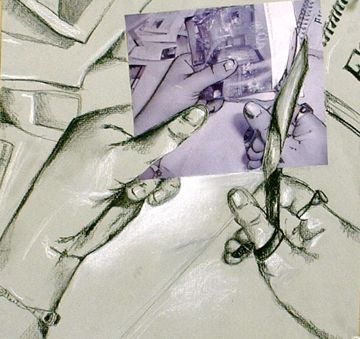Spring is in the air. The end of the school year is upon us, or for those who bob and weave right through June, almost upon us. This is the time of year (and more than once) I’ve thought about getting out the proverbial lounge chair and giving assignments that won’t push too hard and won’t interrupt the slow change from spring to summer outside the window. But you know what? I’ve learned (and more than once) that this is a bad idea.
In a previous post about Rochelle Feinstein’s most recent show (a “retrospective collection, assembled in the present tense,” as explained in Jason Friedman’s wonderful Bomb interview with the artist) I mentioned that Feinstein’s approach reminded me of a favorite series of lessons to teach towards the end of the school year called “Catharsis”. Mainly about release, revisiting older work and re-seeing, the unit focuses on students first taking stock of what they have accomplished during the course- a real thoughtful look through their portfolio and sketchbooks highlighting successes, challenges, and even the flops along the way. Conversations are had, reflections are written. More conversations are had. It drives students bats, but most of the time in a good way.
Then, in a moment of truth, students are asked to pick a single work of art from their portfolio: Something that they want to destroy, change, alter, rip, tear, rearrange or reassemble… and make into a brand new work.
Do I ask them to choose the “worst” piece? No. Do I ask them to pick the work they “hate” the most? Definitely not (I try to avoid using hate as motivation for art when I can). But I will ask them to pick a work that has potential in some ways, just not its current form. I will ask them to pick a work that could be put together differently. Unlike Feinstein’s approach in The Estate of Rochelle F., students are allowed to add to the revised and rearranged work, perhaps drawing into it, adding a new medium, or even changing the medium (drawings can be rearranged and then photographed, for example). Students wrap up by discussing and sharing what the work was originally about vs. what the work became about in its altered form.
In Justin Lieberman’s interview, Rochelle Feinstein goes on to say:
I do believe in a finished work. Yet, if the work is still in my possession, and I’ve concluded that it needs to be “fluffed” because of the current circumstances, then I will do so. The “original” then exists as the foundation for a new “original”.
The end of the school year, instead of being an opportunity to go easy on students who could use one last creative kick in the pants, is a perfect time to take stock of what happened, what was learned, and perhaps create something new and beautiful (?) from work that may very well have been left behind or stuffed under the bed for Rover to snuggle with when the weather turns cold again.




